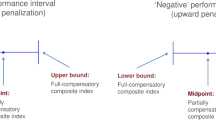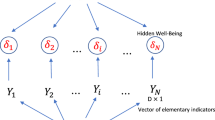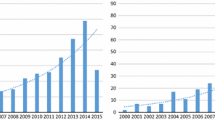Abstract
Composite indices for measuring multidimensional phenomena have become very popular in a variety of economic, social and policy domains. The literature offers a wide range of aggregation methods, all with their pros and cons. The most used are additive methods, but they imply requirements and properties which are often not desirable or difficult to meet. For example, they assume a full substitutability among the components of the index: a deficit in one dimension can be compensated by a surplus in another. In this paper, we consider a non-compensatory composite index for spatial comparisons and its variant for spatio-temporal comparisons. A study of the aggregation function is, for the first time, presented and its main properties are formally defined. As an example of application, a set of individual indicators of well-being for OECD countries is considered and a comparison between the two approaches is provided, in order to show what they offer and how they work.




Similar content being viewed by others
Notes
Note that compensability/non-compensability does not imply dependence/independence and vice versa. For example, “Hospital beds (per 1000 people)” and “Hospital doctors (per 1000 people)” are two dependent (positively correlated) indicators but they are non-substitutable, because a deficit in beds cannot be compensated by a surplus in doctors and vice-versa. “Average water use (per person)” and “Bottled water consumption (per capita)” may be linearly independent (incorrelated) indicators, but they are substitutable.
A measurement model describes the relationship between a concept and its measures (indicators).
Although the reflective model dominates the psychological and management sciences, the formative model is common in economics and sociology (Coltman et al. 2008).
To overcome the assumption of complete substitutability among the indicators, some authors propose multiplicative aggregation methods, such as the geometric mean (OECD 2008; Zhou et al. 2010). However, it can be used only for sets of positive values which are interpreted according to their product and not their sum. Besides, the value of the geometric mean is ‘biased’ low. Thus it may be useful for measuring phenomena like development (e.g., the HDI), but not like poverty.
Variability effect may be minimized by normalizing individual indicators with a method that brings them to have equal or similar variances.
Note that individual indicators are converted to a common scale with a mean of 100 and standard deviation of 10. So, the transformed values will fall approximately in the range (70; 130). The z scores are adjusted to avoid negative values and obtain more visually manageable scores (Booysen 2002).
They refer to column values of the matrix X.
They refer to row values of the matrix Z.
It is a generalized form since it includes ‘two indices in one’.
Note that a change on z ij for the unit i implies a change on z hj for the unit h (h ≠ i), so that the mean and standard deviation of the standardized indicator j are 100 and 10, respectively. On the contrary, a change on r ij for the unit i does not affect the value of r hj for the unit h (h ≠ i).
References
Ács, Z. J., Rappai, G., & Szerb, L. (2011). Index-building in a system of interdependent variables: The penalty for bottleneck. GMU School of Public Policy, Research Paper, 24.
Bandura, R. (2008). A survey of composite indices measuring country performance: 2008 Update. A UNDP/ODS Working Paper, New York.
Booysen, F. (2002). An overview and evaluation of composite indices of development. Social Indicators Research, 59, 115–151.
Casadio Tarabusi, E., & Guarini, G. (2013). An unbalance adjustment method for development indicators. Social Indicators Research, 112, 19–45.
Casadio Tarabusi, E., & Palazzi, P. (2004). An index for sustainable development. BNL Quarterly Review, 229, 185–206.
Coltman, T., Devinney, T. M., Midgley, D. F., & Venaik, S. (2008). Formative versus reflective measurement models: Two applications of formative measurement. Journal of Business Research, 61, 1250–1262.
De Muro, P., Mazziotta, M., & Pareto, A. (2011). Composite indices of development and poverty: An application to MDGs. Social Indicators Research, 104, 1–18.
Diamantopoulos, A., Riefler, P., & Roth, K. P. (2008). Advancing formative measurement models. Journal of Business Research, 61, 1203–1218.
Dunteman, G. H. (1989). Principal components analysis. Newbury Park: Sage Publications.
Fanchette, S. (1974). Social indicators: Problems of methodology and selection. In Unesco, Social indicators: Problems of definition and of selection. Reports and papers in the social sciences, 30, Paris.
Freudenberg, M. (2003). Composite indicators of country performance: A critical assessment. OECD, DSTI/IND, 5, Paris.
Mazziotta, C., Mazziotta, M., Pareto, A., & Vidoli, F. (2010). La sintesi di indicatori territoriali di dotazione infrastrutturale: Metodi di costruzione e procedure di ponderazione a confronto. Review of Economics and Statistics for Regional Studies, 1, 7–33.
Mazziotta, M., & Pareto, A. (2012). A non-compensatory approach for the measurement of the quality of life. In F. Maggino & G. Nuvolati (Eds.), Quality of life in Italy: Research and reflections (pp. 27–40). New York: Springer.
Mazziotta, M., & Pareto, A. (2013). A non-compensatory composite index for measuring well-being over time. Cogito: Multidisciplinary Research Journal, 4, 93–104.
Mazziotta, M., & Pareto, A. (2014). Non-compensatory aggregation of social indicators: An icon representation. In F. Crescenzi & S. Mignani (Eds.), Statistical methods and applications from a historical perspective (pp. 383–391). Cham: Springer.
Munda, G., & Nardo, M. (2009). Non-compensatory/non-linear composite indicators for ranking countries: A defensible setting. Applied Economics, 41, 1513–1523.
OECD. (2008). Handbook on constructing composite indicators. Methodology and user guide. Paris: OECD Publications.
OECD. (2013). How’s life? 2013: Measuring well-being. OECD Publishing,. doi:10.1787/9789264201392-en.
Saisana, M., Saltelli, A., & Tarantola, S. (2005). Uncertainty and sensitivity analysis techniques as tools for the quality assessment of composite indicators. Journal of the Royal Statistical Society, A168, 307–323.
Saisana, M., & Tarantola, S. (2002). State-of-the-art report on current methodologies and practices for composite indicator development. European Commission-JRC, EUR 20408 EN, Ispra.
Saltelli, A. (2007). Composite indicators between analysis and advocacy. Social Indicators Research, 81, 65–77.
Salzman, J. (2003). Methodological choices encountered in the construction of composite indices of economic and social well-being. Technical Report, Center for the Study of Living Standards, Ottawa.
Tangian, A. S. (2005). A composite indicator of working conditions in the EU-15 for policy monitoring and analytical purposes. WSI-Diskussionspapiere, 135, Düsseldorf.
Tarantola, S. (2008). European innovation scoreboard: Strategies to measure country progress over time. JRC Scientific and Technical Reports, EUR 23526 EN, Luxembourg.
UNDP. (2007). Human development report 2007/2008. New York: Palgrave Macmillan.
UNDP. (2010). Human development report 2010. New York: Palgrave Macmillan.
Zhou, P., Ang, B. W., & Zhou, D. Q. (2010). Weighting and aggregation in composite indicator construction: A multiplicative optimization approach. Social Indicators Research, 96, 169–181.
Author information
Authors and Affiliations
Corresponding author
Rights and permissions
About this article
Cite this article
Mazziotta, M., Pareto, A. On a Generalized Non-compensatory Composite Index for Measuring Socio-economic Phenomena. Soc Indic Res 127, 983–1003 (2016). https://doi.org/10.1007/s11205-015-0998-2
Accepted:
Published:
Issue Date:
DOI: https://doi.org/10.1007/s11205-015-0998-2




